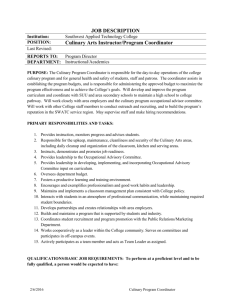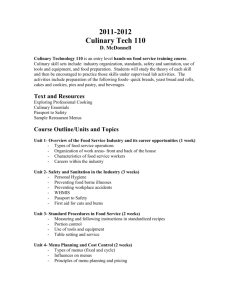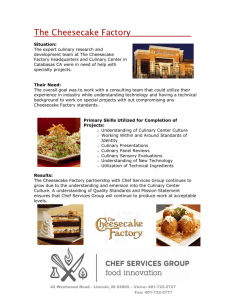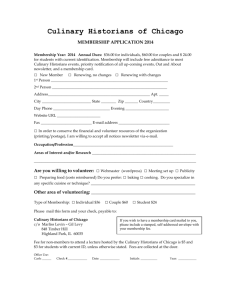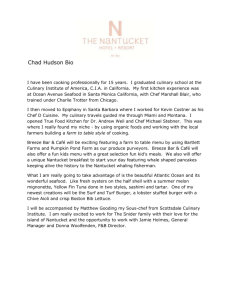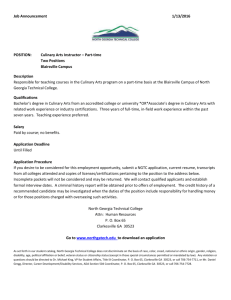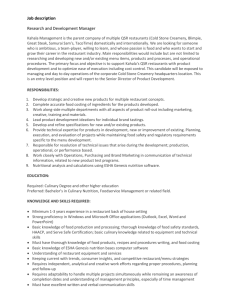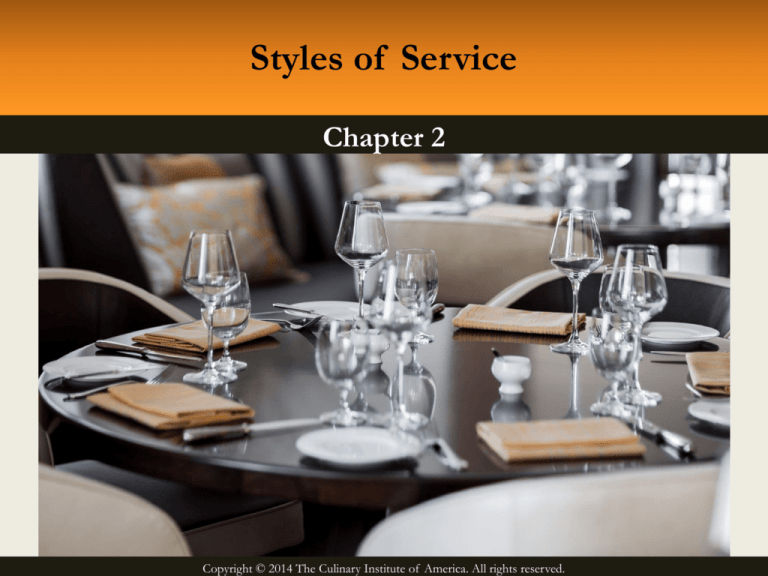
Styles of Service
Chapter 2
Copyright © 2014 The Culinary Institute of America. All rights reserved.
Learning Objectives
• Learn and understand how the history and traditions of table
service affect service today.
• Trace the evolution of etiquette in Western dining from Greeks
and Romans up to the present day.
• Describe the rise of modern restaurants and table service.
• Understand the sequence of courses in a menu.
• Define and describe various types of menus.
• Explain the classic hierarchy found in the front of the house.
• Define and describe various styles of service.
• Explain the term house style.
Copyright © 2014 The Culinary Institute of America. All rights reserved.
The History and Traditions of Table Service
• Western-style dining is found in the Bible, as well as Homer’s Iliad
and Odyssey.
• Formal dining, as we know it today, was reserved for wealthy
men.
• Meals were divided into three courses: small savory meat dishes,
followed by a hearty course, and desserts.
• Symposiums commonly followed the meal, with a mix of literary
and philosophical discussions, music, acrobats, and dancers.
Copyright © 2014 The Culinary Institute of America. All rights reserved.
The History and Traditions of Table Service
(cont’d)
• Unlike the Greeks, Roman families often dined together.
• Being invited to dine signaled social recognition that was much
sought after.
• Guests had their positions assigned according to status.
– This is echoed today in the tradition of seating the guest of
honor to the right of the host.
Copyright © 2014 The Culinary Institute of America. All rights reserved.
The History and Traditions of Table Service
(cont’d)
The Evolution of Etiquette and Table Manners in Europe
• In Anglo-Saxon times, the first item placed on the table was the
salt cellar.
– This determined the status of diners: high-status diners ate
“above the salt.”
• In the late fourteenth century, people began to think of food
and its service as art forms.
• During the Renaissance in the fifteenth century, dining and
service became more elaborate.
• Some historians trace the origins of classic fine dining to the
Medicis of Florence, sixteenth-century aristocrats.
Copyright © 2014 The Culinary Institute of America. All rights reserved.
The History and Traditions of Table Service
(cont’d)
The Evolution of Etiquette and Table Manners in Europe (cont’d)
• With Elizabeth I (1533–1603), table manners came to be
expected of refined diners.
• Braithwaite’s Rules for the Governance of the House of an Earl (1617)
listed spoons and knives as essentials, but did not mention forks.
• The dining room began to be a place of pomp and protocol.
– The brigade system was introduced in the dining room.
– The term amphitryon is used in place of the old term officer of
the mouth, now known as the host.
Copyright © 2014 The Culinary Institute of America. All rights reserved.
The History and Traditions of Table Service
(cont’d)
The Rise of Modern Restaurant and Table Service (cont’d)
• After the French Revolution, chefs were artists as well as
entrepreneurs.
• In 1782, A. B. Beauvilliers opened the first modern restaurant,
Le Grand Taverne de Londres in Paris.
• American dining grew out of the necessity to feed many people
spread out over the continent.
– Evolved during the Industrial Revolution.
• In 1900, the first edition of Le Guide Michelin in France reflected
the changes in modern society.
Copyright © 2014 The Culinary Institute of America. All rights reserved.
The History and Traditions of Table Service
(cont’d)
Menus and Sequence of Courses
• The basic sequence of courses in most Western menus is based
on that of the ancient Greeks.
– The meal should build to a climax at the main course, then
gradually relax to lighter foods.
• Cold foods before warm; light foods before heavy.
• Three courses: entrée, relevés, entremets.
Copyright © 2014 The Culinary Institute of America. All rights reserved.
The History and Traditions of Table Service
(cont’d)
Types of Menus
• The table d’hôte menu offers
a multicourse meal for a set
price and typically offers a
few choices for each course.
• The prix fixe menu differs in
that there are no options on
the menu.
© 2014 The Culinary Institute of America
Copyright © 2014 The Culinary Institute of America. All rights reserved.
The History and Traditions of Table Service
(cont’d)
Types of Menus (cont’d)
• Beauvilliers contributed the à
la carte menu (literally, “from
the card”).
• Guests order individually
priced items and structure
the meal how they choose.
© 2014 The Culinary Institute of America
Copyright © 2014 The Culinary Institute of America. All rights reserved.
The History and Traditions of Table Service
(cont’d)
Types of Menus (cont’d)
• A dégustation (“tasting
menu”) consists of small
portions of numerous items
to compose a five- to tencourse meal.
• Allows chefs to exhibit their
skills creating an extensive
and varied meal.
© 2014 The Culinary Institute of America
Copyright © 2014 The Culinary Institute of America. All rights reserved.
Dining Room Brigade
Classical/Historical Structure
Maître d’hôtel
The manager of the house or the entire operation is also known
today as general manager.
Réceptionniste
The receptionist greets the guests, takes phone reservations, and
looks after the needs of the front desk area.
Chef de rang
The captain is in charge of service in a particular station of tables.
Sommelier
The wine steward is responsible for the recommendation of wines
to guests, and the wine service itself.
Copyright © 2014 The Culinary Institute of America. All rights reserved.
Dining Room Brigade (cont’d)
Classical/Historical Structure (cont’d)
Head waiter
The head waiter may have the responsibilities of the maître d’hôtel,
or act as the captain of a dining room.
Commis de rang
The front waiter works to assist the captain in managing a station.
Commis de suite
The back waiter generally assists the front waiter.
Commis de
débarrasseur
The bus person is often an apprentice or trainee.
Copyright © 2014 The Culinary Institute of America. All rights reserved.
Dining Room Brigade (cont’d)
Organization Charts (cont’d)
• One way to better understand the hierarchy of the restaurant as a
total unit is to use an organization chart.
• The more casual the restaurant, the fewer staff members are
needed to provide good service.
• In a casual restaurant, the server would do the duties of the
captain and front and back waiters.
Copyright © 2014 The Culinary Institute of America. All rights reserved.
Dining Room Brigade (cont’d)
Organization Charts (cont’d)
• Fine dining restaurants have
staff to fill most, if not all,
of the traditional dining
room brigade positions.
© 2014 The Culinary Institute of America
Copyright © 2014 The Culinary Institute of America. All rights reserved.
Dining Room Brigade (cont’d)
Organization Charts (cont’d)
• In France, a typical bistro
would have no captains.
• Service positions would
include chef de rang, commis
de rang, or demi-chef de
rang.
OWNER or GENERAL
MANAGER
CHEF
ASSISTANT CHEF
LINE COOK
KITCHEN HELP
FLOOR MANAGER or
MAÎTRE D‘HÔTEL
(Host)
WAITER
RUNNER
BUSPERSON
BARTENDER
BAR BACK
Copyright © 2014 The Culinary Institute of America. All rights reserved.
Dining Room Brigade (cont’d)
Organization Charts (cont’d)
• Chain restaurants may have
fewer positions as part of
their overall dining room
brigade.
• Service is generally more
relaxed than a fine dining
restaurant.
CEO
REGIONAL MANAGER
DISTRICT MANAGER
GENERAL MANAGER
SHIFT MANAGERS
CHEF
ASSISTANT CHEF
LINE COOK
POT WASHER
STEWARD
Copyright © 2014 The Culinary Institute of America. All rights reserved.
HOST
SERVER
BUSPERSON
Styles of Service
French Service
• Today’s formal service style has its roots in service à la française.
• Formal French service typically requires a sommelier, captain,
front waiter, back waiter, and busser.
• This style can be prohibitively expensive for restaurants.
• The traditional outfit for servers performing formal French
service is black tie and white gloves.
Copyright © 2014 The Culinary Institute of America. All rights reserved.
Styles of Service
The Guéridon
• In formal service, the guéridon is center stage in the service act.
• It might be used for mixing salads, deboning fish, or carving
meat.
• Guéridon service is very similar to formal service, except that
some items are fully prepared tableside.
Copyright © 2014 The Culinary Institute of America. All rights reserved.
Styles of Service (cont’d)
Voiture and Trolley Service
• A voiture is a decorative cart, also known as a “trolley,” equipped
with a heating unit and a hinged cover.
• Voitures are larger than guéridons and can hold an entire roast.
• Voiture service refers to the plating of a precooked main course,
at the guest’s table, from a voiture.
Copyright © 2014 The Culinary Institute of America. All rights reserved.
Styles of Service (cont’d)
Russian, or Platter, Service
• All food is fully cooked and artfully arranged and garnished on
large platters in the kitchen.
• The platters are carried to the dining room and presented by a
server, who then transfers the food to the guests’ plates.
• Russian (French) service is mostly used for banquets today.
• It is common for waiters to use Russian (French) service to place
bread on guests’ plates.
Copyright © 2014 The Culinary Institute of America. All rights reserved.
Styles of Service (cont’d)
Butler Service
• Often used today when passing hors d’oeuvre or cocktails for
guests during a cocktail hour.
• Hold the filled tray/platter in the left hand, leaving the right
hand free to offer napkins to the guests from a small plate.
Copyright © 2014 The Culinary Institute of America. All rights reserved.
Styles of Service (cont’d)
English Service
The host, or perhaps the maître d’hôtel, offers the food from
platters, bowls, or tureens from the guest’s left.
• The guests take the food themselves as in Butler service.
• Server moves counter-clockwise around the table.
• Another form of English service:
• The host serves the food onto the plates at the head of the table,
then hands filled bowls or plates to the nearest diner, who then
passes them along the table.
Copyright © 2014 The Culinary Institute of America. All rights reserved.
Styles of Service (cont’d)
Family Service
• All or some of the foods are placed on the table in large serving
dishes, and guests help themselves.
• Serving utensils are required in each bowl or platter.
Copyright © 2014 The Culinary Institute of America. All rights reserved.
Styles of Service
American Service
• Most widespread style.
• Food is plated in the kitchen
and served to the guest at the
table.
© 2014 The Culinary Institute of America
Copyright © 2014 The Culinary Institute of America. All rights reserved.
Styles of Service
Service Styles Review Quiz
Name the style:
• A restaurant could use several styles during the same service.
1.) Some plates could be plated in the kitchen.
• 2.) Some plates could be prepared or plated tableside.
• 3.) Butter could be offered on the table for guests to serve
themselves.
• 4.) The server could place bread onto the guest’s b&b plate
from the guest’s left moving counter-clockwise around the
table.
• 5.) A small bit of food (amusé bouche) offered to the guest
after the order is taken for the guest to take herself._______
Copyright © 2014 The Culinary Institute of America. All rights reserved.
House Style
Restaurant Types
Type of
Restaurant
Fine
Dining
Description
Upscale, luxury, three-, four-, and five-star, “white-tablecloth”
restaurants.
Examples: Jean-Georges, Nobu, The French Laundry
Bistro/Tra Grills, cafés. All have less ceremonious approaches to food
ttoria
service.
Examples: Da Silvano, Lulu, Spago, Wild Ginger
Casual/F
amily
Family-style restaurants
Examples: Olive Garden, Applebee’s, Ruby Tuesday
Copyright © 2014 The Culinary Institute of America. All rights reserved.

